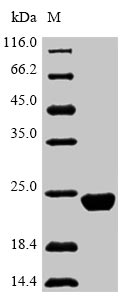Purity
Greater than 90% as determined by SDS-PAGE.
Alternative Names
Slc7a10; Asc1; Asc-type amino acid transporter 1; Asc-1; D-serine transporter; Solute carrier family 7 member 10
Species
Mus musculus (Mouse)
Tag Info
N-terminal His-tagged
Tag-Free
Form
Liquid or Lyophilized powder
Note: We will preferentially ship the format that
we have in stock, however, if you have any special requirement for the format, please remark your
requirement when placing the order, we will prepare according to your demand.
Buffer
If the delivery form is liquid, the default storage buffer is Tris/PBS-based buffer, 5%-50% glycerol.
Note: If you have any special requirement for the
glycerol content, please remark when you place the order.
If the delivery form is lyophilized powder, the buffer before lyophilization is Tris/PBS-based buffer,
6% Trehalose, pH 8.0.
Reconstitution
We recommend that this vial be briefly centrifuged prior to opening to bring the contents to the bottom. Please reconstitute protein in deionized sterile water to a concentration of 0.1-1.0 mg/mL.We recommend to add 5-50% of glycerol (final concentration) and aliquot for long-term storage at -20°C/-80°C. Our default final concentration of glycerol is 50%. Customers could use it as reference.
Storage Condition
Store at -20°C/-80°C upon receipt, aliquoting is necessary for mutiple use. Avoid repeated freeze-thaw
cycles.
Shelf Life
The shelf life is related to many factors, storage state, buffer ingredients, storage temperature
and the stability of the protein itself.
Generally, the shelf life of liquid form is 6 months at -20°C/-80°C. The shelf life of lyophilized
form is 12 months at -20°C/-80°C.
Lead Time
3-7 business days
Notes
Repeated freezing and thawing is not recommended. Store working aliquots at 4°C for up to one week.
Datasheet & COA
Please contact us to get it.
Description
The recombinant Mouse Slc7a10 was expressed with the amino acid range of 475-530. This Slc7a10 protein is expected to have a theoretical molecular weight of 22.5 kDa. This Slc7a10 protein is produced using yeast expression system. The Slc7a10 gene fragment has been modified by fusing the N-terminal 6xHis-sumostar tag, providing convenience in detecting and purifying the recombinant Slc7a10 protein during the following stages.
The mouse asc-type amino acid transporter 1 (Slc7a10) is a sodium-independent amino acid transporter that facilitates the uptake of small, neutral amino acids into cells. Slc7a10 is prominently expressed in the brain, particularly in regions like the hippocampus and cortex. The Slc7a10's presence in these areas suggests its role in regulating amino acid levels crucial for neurotransmission and neuronal function. Studies have linked alterations in Slc7a10 expression to neurological disorders. It may play a role in maintaining amino acid homeostasis in the central nervous system. Understanding the function of mouse Slc7a10 is essential for unraveling its role in amino acid metabolism, neurotransmission, and potential contributions to neurological disorders in mice.






